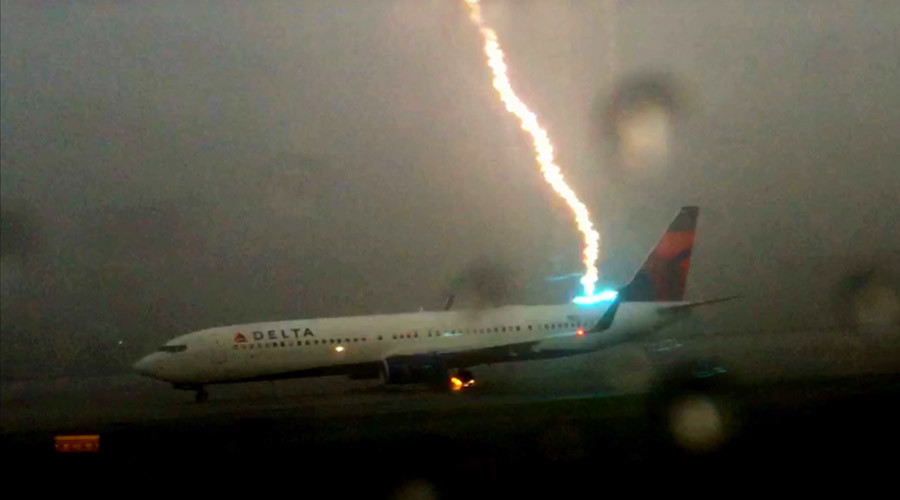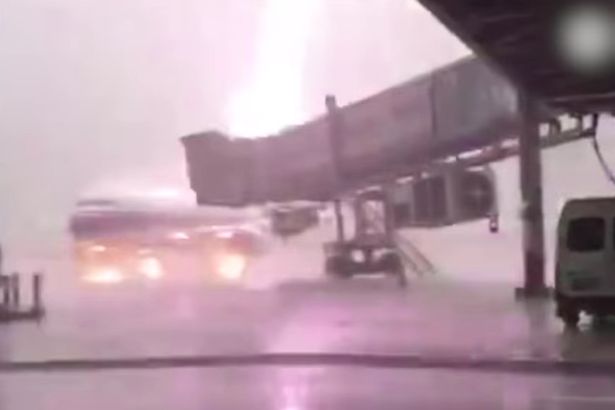What Happens When Lightning Hits An Airplane? Has It Ever Resulted In A Crash?
'Fact Or Fake': In 2016 so far, 5 reported cases of planes being struck by lightning.
The short answer to the question "what happens when lightning hits an airplane" is nothing. However, the fact that lightning strikes have resulted in airplanes to crash demands a detailed answer.
Screenshot of a video that captured the moment when a Delta plane was struck by a powerful lightning bolt while on a runway in Atlanta last year.
Image via Jack Perkins/YouTubeFirst of all, lightning strikes an airplane more often than you think!
In 2016 so far, there have been 5 reported cases of airplanes being hit by lightning.
Earlier this year, on 5 February, an Etihad Airways flight's right wing was hit by lightning as it flew through turbulent weather. The plane made a safe landing in Paris shortly after.
Two months later, on 27 April, a British Airways airliner and an Icelandair aircraft got zapped by lightning while flying over London. While passengers felt a "crack" and "bang" as the planes were hit by lightning, no one was hurt.
On 31 May, a commercial plane, parked at Jieyang Chaoshan International Airport in China, was struck by a massive bolt of lightning, leaving the plane's wheels covered in flames. There was no one inside the plane at the time of the incident.
The most recent case of lightning hitting an airplane happened on 17 June this year, when a Thomson Airways plane, traveling from Manchester to Morocco, was forced to make an unexpected landing after it was struck by lightning.
That said, it is absolutely rare for airplanes struck by lightning to pose a threat to the crew and passengers inside. This is why:
"The energy does not travel through the cabin electrocuting the passengers; it is discharged overboard 9 times in 10 leaving little or no evidence of the strike itself," commercial airline pilot and AskThePilot.com blogger Patrick Smith said.
However, while the incidents of lightning strikes on the tarmac and in the mid-air are fairly common, the greatest potential danger to people of lightning hitting an airplane is probably on the ground
As The Washington Post's Jack Williams explains, the threat lightning strikes pose primarily lie in where the energy dissipates as the current becomes grounded.
"For example, in 1989, lightning killed an airline employee who was talking to the crew using a headset connected to the airplane by a wire when lightning hit the airplane. The plane was being pushed back from a gate at Orlando International Airport. Furthermore, letting passengers leave or board an airplane on outside metal stairs, rather than on an enclosed jet way, is also dangerous when you can see lightning or hear thunder."
There is one part of the plane, though, which if struck by lightning can result in serious damage. It's the radome (the nose cone), as it's the only part of a plane's shell that's not made of metal. However, nose cones have special lightning conductors for just this reason.
Although passengers and crew may see a flash and hear a loud noise if lightning strikes their plane, nothing serious should happen because of the careful lightning protection engineered into the aircraft and its sensitive components.
Initially, the lightning will attach to an extremity such as the nose or wing tip. The airplane then flies through the lightning flash, which reattaches itself to the fuselage at other locations while the airplane is in the electric "circuit" between the cloud regions of opposite polarity.
The current will travel through the conductive exterior skin and structures of the aircraft and exit off some other extremity, such as the tail.
In other words, while an incredibly unlikely event, lightning strikes, coupled with bad weather, can cause some form of minor turbulence, given the fact when lightning zaps an airplane it sends currents of up to 200,000 amperes through its skin and frame.
Despite that, you shouldn't be worried about lightning striking the plane you're in. Because, as President and CEO, William Voss, of the Flight Safety Foundation, explained to CNN, "lightning is just not a real big issue."
"The things that surround lightning, like the turbulence, the wind shear and so on associated with thunderstorms are far greater hazards than the lightning, even though lightning is by its nature a bit frightening," said Voss.
Through 'Fact Or Fake', we at SAYS try to keep the Internet free from bullsh#t by debunking urban legends and popular myths
The very first weekly column at SAYS that began in 2013, 'Fact Or Fake' hit a roadblock at the start of this year and was put into hibernation. However, on 28 May 2016, we brought it back in order to better serve our loyal readers.
You too can help us in our this weekly myth-buster endeavour by sending us any tips, myths you think we should look into and debunk.
Send your suggestions to [email protected] with 'Submission for Fact Or Fake' as the subject line. If we like what we see, we will debunk it for you. ;)



